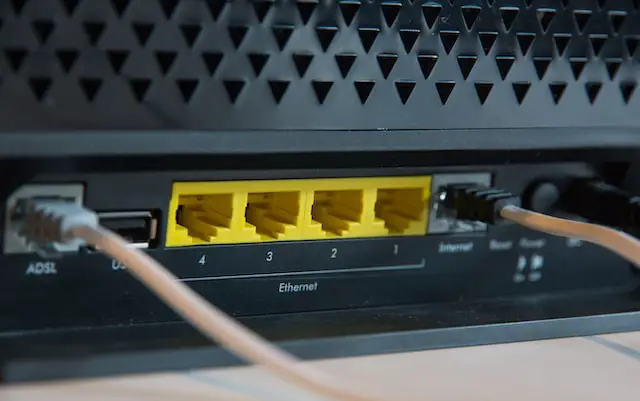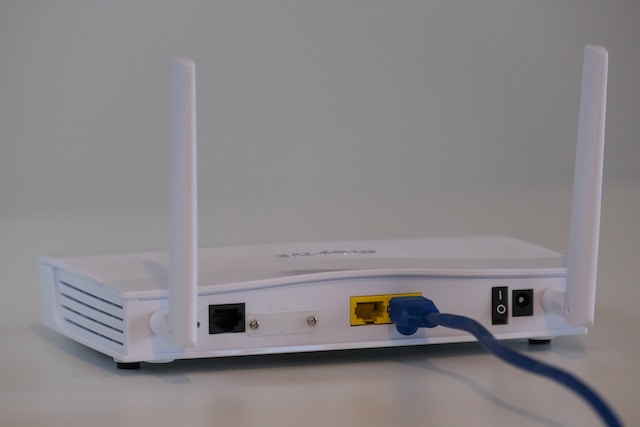A modem is a device that connects a computer or other device to the internet through an internet service provider (ISP) and converts digital signals to analog signals for transmission over a telephone line or cable. A router is a device that connects multiple devices within a local area network (LAN) and directs network traffic between them, while also providing a connection to the internet through a modem.
What is a modem?
(Photo by Stephen Phillips – Hostreviews.co.uk on Unsplash )

A modem (short for modulator-demodulator) is a device that connects a computer or other device to the internet through an internet service provider (ISP) by converting digital signals to analog signals for transmission over a telephone line or cable. The modem receives data from the ISP, modulates it into analog signals that can be transmitted over the communication line, and then demodulates the analog signals back into digital signals that can be interpreted by the computer or other device. Modems can be used for various types of internet connections, such as dial-up, DSL, cable, or fiber-optic.
What is a router?
(Photo by Compare Fibre on Unsplash )

A router is a networking device that connects multiple devices within a local area network (LAN) and directs network traffic between them, while also providing a connection to the internet through a modem. Routers use routing tables and protocols to determine the most efficient path for data to travel between devices on the network. They also provide security features such as firewalls and network address translation (NAT) to protect devices on the network from external threats. Routers can be wired or wireless, and are commonly used in homes and businesses to connect computers, smartphones, tablets, and other devices to the internet.
Modem Vs. Router – Key differences
Function: A modem is a device that converts digital signals to analog signals for transmission over a telephone line or cable, while a router is a networking device that connects multiple devices within a local area network (LAN) and directs network traffic between them, while also providing a connection to the internet through a modem.
Connection: A modem connects to an ISP and provides a single device with internet access, while a router connects to a modem and allows multiple devices to connect to the internet through the same connection.
IP addresses: A modem provides a single IP address to a device, while a router assigns unique IP addresses to each device on the network, allowing them to communicate with each other.
Security: A modem does not provide any security features, while a router can provide security features such as firewalls, network address translation (NAT), and virtual private network (VPN) support to protect devices on the network from external threats.
Wireless access: While some modems may have built-in wireless access points, their main function is to provide a wired connection to a single device. A router, on the other hand, is designed to provide wireless access to multiple devices and can be used to extend the range of a Wi-Fi network.
How to choose the right modem your needs?
Your modem is the device that allows you to connect to the Internet, and your router is the device that allows you to connect multiple devices to each other and share an Internet connection. So, how do you know which one is right for your needs?
Here are a few things to consider when choosing a modem:
- What type of Internet connection do you have? Cable, DSL, or fiber? Each type of Internet connection requires a different type of modem. For example, cable modems are not compatible with DSL or fiber connections.
- What speed do you need? Modems are available in a variety of speeds ranging from slow (under 10 Mbps) to very fast (over 1 Gbps). The speed you need will depend on how you plan to use your Internet connection. If you just want to browse the web and check email, a slower modem will suffice. However, if you plan to stream video or play online games, you’ll need a faster modem.
- Do you need Wi-Fi? Some modems come with built-in Wi-Fi routers while others do not. If you need Wi-Fi, make sure to choose a modem with a router.
- Do you need phone service? Some modems include phone jacks for landline telephone service. If you don’t need phone service, there’s no need to pay for a modem with this feature.
How to choose the right router for your needs?
When choosing a router, there are several factors to consider that will help you find the one that meets your needs. Here are some tips to help you choose the right router for your needs:
- Speed: Consider the speed of the router, which is measured in Mbps. Look for a router with a high speed rating if you plan to use it for bandwidth-intensive activities such as streaming video, gaming, or large file transfers.
- Range: Consider the range of the router, which is the distance it can transmit its wireless signal. Look for a router with a strong signal that can cover your entire home or office.
- Wi-Fi standard: Consider the Wi-Fi standard supported by the router. The latest standard is Wi-Fi 6, which offers faster speeds and better performance in crowded environments. If you have older devices, you may want to consider a router that supports older Wi-Fi standards such as Wi-Fi 5 or 4.
- Number of devices: Consider the number of devices that will be connected to the router. Look for a router that can support the number of devices you need to connect simultaneously.
- Security: Consider the security features offered by the router, such as firewalls, VPN support, and parental controls.
- Brand and reviews: Consider the brand reputation and read reviews from other users to get an idea of the reliability and performance of the router.
- Price: Consider your budget and look for a router that offers the features you need at a price point that works for you.
By considering these factors, you can find a router that meets your needs and provides reliable, high-speed internet connectivity.
Do I need a router if I have a modem?
If you have a modem, you may not need a router. A router connects your devices to the Internet and allows them to communicate with each other. If you only have one device, such as a computer, and it has a built-in Ethernet port, you can connect it directly to your modem using an Ethernet cable.
What are the types of routers?
There are several types of routers available on the market, each with its own unique features and capabilities. Here are some of the most common types of routers:
- Wired routers: These are traditional routers that provide wired connectivity to devices via Ethernet cables. They are typically used in businesses and homes where wired connections are preferred for stability and security.
- Wireless routers: These routers provide wireless connectivity to devices through Wi-Fi signals. They are commonly used in homes and small businesses to provide wireless internet access to laptops, smartphones, and other mobile devices.
- Dual-band routers: These routers provide both 2.4 GHz and 5 GHz Wi-Fi bands, allowing for more flexibility in connecting devices. The 2.4 GHz band provides a longer range but slower speeds, while the 5 GHz band offers faster speeds but shorter range.
- Tri-band routers: These routers provide three Wi-Fi bands, typically one 2.4 GHz band and two 5 GHz bands. They are designed for high-performance applications and can support multiple devices simultaneously.
- Mesh routers: These routers use multiple nodes to create a mesh network that can provide better coverage and eliminate dead spots. They are typically used in larger homes or businesses with multiple floors.
- Gaming routers: These routers are optimized for low latency and high-speed internet connectivity, making them ideal for online gaming and streaming.
- VPN routers: These routers support VPN connections, allowing users to connect to a remote network securely.
By understanding the different types of routers available, you can choose the one that best meets your needs for internet connectivity.
Featured Image By – Praveen kumar Mathivanan on Unsplash







